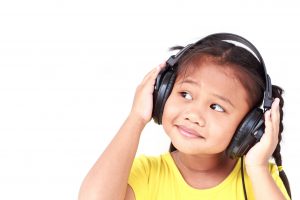
Auditory Processing Center individualizes auditory training sessions to treat each patient’s profile. Treatment goals are customized to improve auditory processing for each deficit area. This may include a combination of internet-based programs in addition to therapy sessions with our audiologist, depending on each listener’s specific needs. APD therapy sessions are typically once or twice a week, either in the clinic or virtually via teletherapy. Patients are also provided with activities to work on at home. Goals may include a combination of activities, such as:
- Auditory Discrimination
- Phonemic Awareness
- Auditory Memory / Auditory Sequencing
- Auditory / Language Organization
- Auditory Closure
- Auditory Vigilance
- Dichotic Listening
- Inter-hemispheric Transfer of Information
- Localization / Spatial Hearing
- Speech-in-Noise / Auditory Figure-Ground
- Noise Desensitization
- Temporal Patterning
- Prosody Training
- Auditory Comprehension
- Auditory Cohesion / Higher-Level Language Processing
- Buffalo Model APD Therapy
- Multi-sensory Phoneme Training using Right Brain Strategies
- Auditory Processing Center’s Phoneme Training Curriculum
Guided home therapy programs for the treatment of auditory processing disorders. Patients are provided with online access to recordings of listening activities and material through our patient portal. Programs are customized and assigned based on each listener’s auditory processing deficits. Deficit-specific lessons for auditory processing disorder guide a listener through gradually more challenging tasks. Program options include online binaural separation in noise training, words in noise training, and binaural integration training. We also offer a guided home therapy program with weekly lesson plans and materials to address additional deficit areas.
- Online Binaural Separation in Noise Program. This program is accessed through an internet browser and our patient therapy portal. It is a series of 23 sessions targeting binaural separation to enable the practice of shifting attention to one ear. A listener must be able to direct his or her attention to one ear to understand a message coming from that side while ignoring a message presented to the opposite ear at the same time. This is a skill we use when we are on the phone and it is also needed so that we can shift our focus to one side as a teacher or speaker moves from one side of the room to the other. Even soft noises that most people can easily ignore and don’t typically notice (i.e., air conditioners, humming from computers, coughing, tapping pencils) can override the talker’s voice if a listener cannot easily shift his or her attention to the direction of the talker. Selective attention, sound localization, and lateralization skills are needed to be successful in this area of auditory processing.
- Words in Noise Training. This program is accessed through an internet browser and our patient therapy portal. It is a total of 21 sessions, along with baseline testing and post-therapy testing, that allow at-home practice to improve the ability to understand speech in the presence of noise and enable a person to become more tolerant of background noise. Difficulty understanding speech in noise is one of the most common problems in individuals with an auditory processing disorder. Through these at-home exercises, listeners can improve their ability to extract pertinent auditory information from a noise background.
- At-Home Binaural Integration Training. When the central auditory system can adequately code all information reaching both ears, effective binaural integration takes place. The auditory system cannot accurately code, integrate, or preserve all features arriving at the two ears if the ears are not in sync and do not work well as a team. Patients are provided with online access to recordings of dichotic listening activities through our patient portal, which guides them through gradually more challenging tasks to improve binaural integration. This program uses competing words, where different words are presented to each ear at the same time, and the listener must identify and combine (integrate) these two different messages. When working on binaural integration, the pathways that connect both brain hemispheres are strengthened and can work more efficiently. This improves the listener’s ability to bring together information from different areas of the brain and be able to use multiple brain areas simultaneously.
- Guided Home Therapy for Auditory Processing Disorder. For adult patients and parents wanting to work with their child on improving auditory processing skills, we provide weekly lesson plans and customized materials to address deficit areas. These activities are designed to be completed at home, typically three days a week for 20-30 minutes. Activities are customized to target auditory processing weaknesses using a combination of apps, worksheets, and audio recordings with score sheets.




